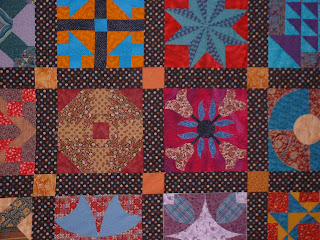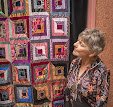
An article I found 10 years ago on The Virtual Quilt, by Catherine Jones, seems to me as interesting and relevant today as it was then. The question she asked was this: what is the status of straightforward geometric patchwork in a time of ever more adventurous experimentation with the medium of the quilt? 10 years on, this trend shows no sign of losing its impetus, to the point where many people describe themselves as "textile artists" rather than quilters and use a huge variety of techniques to achieve their aims.
Interestingly, many textile artists who started out in the quilt world tend to at least keep a toe in those waters, to exhibit at quilt shows and to teach and give talks on patchwork and quilting. Several reasons for this could be advanced; a significant feature of the quilting world at large is the sense of community and bonding it engenders. Even people who have deviated from the mainstream retain affectionate friendships and liaison within the quilting world, while the less adventurous enjoy talks and classes with well-known makers who may challenge their assumptions and inspire them to experiment and explore. (The result is the eclecticism in styles and techniques of quilts seen at exhibitions today - everyone seems to be dyeing, painting, manipulating …….the list goes on.) There is also the fact that growth in the number of people becoming involved in patchwork and quilting, especially through the proliferation of groups and dedicated quilting shops, provides a useful and easily accessed client base for many textile artists.
But back to Catherine Jones's question. Where does this leave today’s patchwork quilt maker, someone who doesn’t wish to paint or dye fabric or turn their quilt into a collage, someone who enjoys straightforward piecing of geometric shapes? Can this be art? Jones broadens her discussion by placing patchwork in the context of geometric art forms found throughout the ages in many cultures and traditions. First, she argues that geometric art, with its straight lines and orderly arrangement which make it look so deceptively simple, challenges common expectations of what qualifies as "art". Furthermore, it conceals the mark of the maker's hand and Furthermore, it conceals the mark of the maker's hand and discourages last-minute creative revision. "In an era that prizes individuality and the frenzy of artistic inspiration, geometric work can come across as too impersonal, too well-crafted and too deliberate."
Jones also points out that except in certain instances, most notably the world of Islamic geometrical art forms, crafts based on these forms have been traditionally associated with relatively underprivileged social groups, that is to say with people who don't usually function as mainstream arbiters of artistic taste. Both patchwork and basketry, for example, have at times been associated with poverty and a make-two-and-mend ethos. The art historian, Oleg Grabar, in a lecture he gave at the National Gallery of Art, after making a survey of non-Islamic ornament, concluded as follows "….. the areas and claims that most consistently exhibit geometric ornamentation are at the periphery of major cultural centres or at the edges of dominating social classes". He went on to speculate that "….. geometry was the privilege of the illiterate, the remote, the popularly pious, the women using (and/or making) textiles and ceramics". Grabar described the graphic artist M.C.Escher, famous for his geometric works, despite falling in to none of these underprivileged categories, as "an orphan within the pantheon of contemporary painters and draughtsman".
All these attitudes conspire, in subtle ways, to relegate patchwork to an inferior status. Jones is dismissive of attempts to upgrade the work of some contemporary quilt-makers by comparing it to that of celebrated artists, such as Mondrian, or by linking it with jazz. She says "linking quilt-making with jazz - with free-form, urban music performed mostly by men - is a tempting way to upgrade the status of a geometrical and traditionally rural, feminine, textile-based art form. But I question whether the analogy holds and whether the constrained, geometric nature of patchwork may not, in fact, be a positive feature, a source of artistic power.”I hereby declare an interest: I love mosaic patchwork more than any other style, and will argue in further postings that its possibilities as a channel of artistic expression are inexhaustible.
Illustration shows geometric patchwork: 'Cross Patch', a variation on a Nine-patch block.











